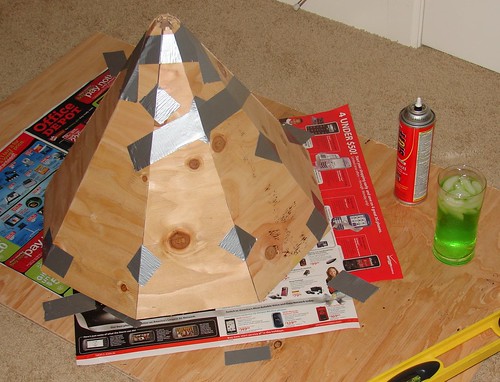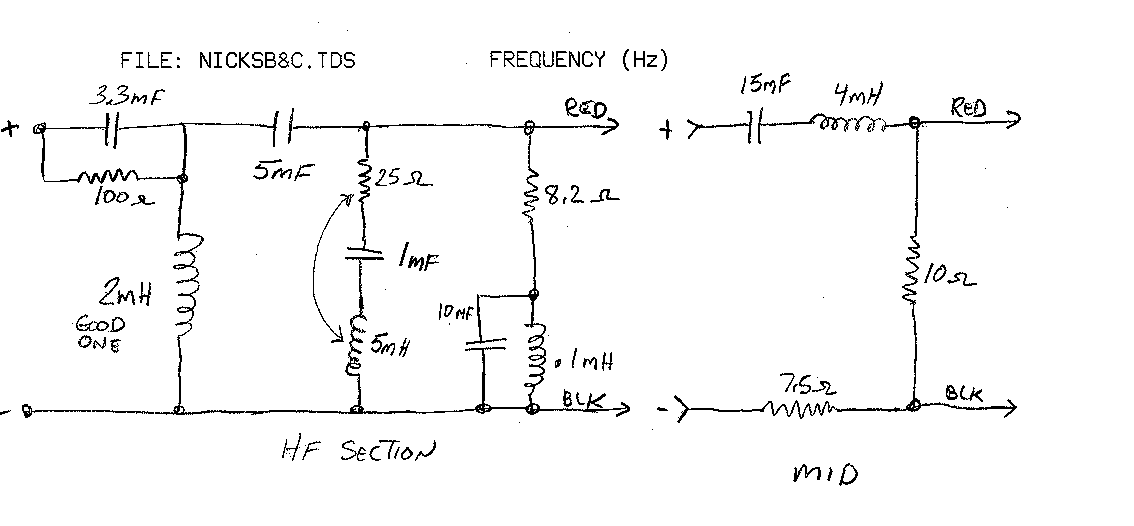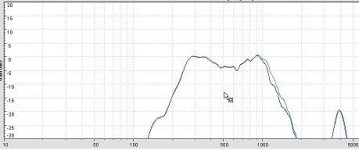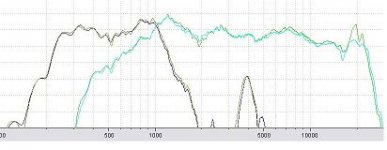That's what I've found as well in the past, but I did spend days trying to fix this one, so far with no luck. The internal sound card is of course worthless - the input is only mono. But even with a nice PCMCIA soundcard I've previously used successfully, I cannot make this one work. I've tried all sorts of driver and software mixer things and corresponding with the soundcard manufacturer and it will not happen. Evidently it is something hardwired (or coded or whatever) into the system. Other people report the same problem on the manufacturer's (Lenovo) support forums. It's only with newer models. I'm just glad it's not one that I paid money for.
nickmckinney said:Its not commonly used anymore because of its uncommon price tag, but the TAD2001 has a very high and smooth response for a 1". I haven't personally measured better on my horn but I also haven't compared it to that many others (Radian, B&C, etc) It also has a 3" or so long smooth tapered throat between the phase plug and the exit. I always wondered how much that extra throat length helped with its response.
It seems like the longer throat of the TAD (which I have), would complicate a passive crossover a little. At present, I'm using a DEQX, so timing is easy to correct for - at least in principle. The one tricky part is that the impulse response for the midrange is not so obvious to interpret, as there is no steep rise. I presume that this is due to the bandpass nature of the mid range set up. At some point, I'd like to try optimizing a passive mid/high filter.
Thanks for the comments regarding the corner fill also.
Patrick Bateman said:My Summas have a plug of foam that's about ten inches deep. If I build a Unity with a 30" mouth, it will require a foam plug that's about TWENTY SIX inches deep.
One thing I noticed when putting the foam into a tractrix horn was that the improvement was more audible than it was with a oblate spheroidal waveguide. With the OS waveguide the improvement was noticeable; with the tractrix it was substantial.
One thing I'm curious to find out is if the 30" waveguide will see a more noticeable improvement with the foam plug. In other words, is there a point of diminishing returns, where too much foam is making no further improvements? The 30" waveguide will require a foam plug about four times as big, and the efficiency will suffer as a result.
It should be interesting to find out, to say the least.
The Lambda Unity's that I have are about 14'' from front edge to the phasing plug of the TAD. To my ears, I found little, if any, difference between the foam extending about 7" from the plug, or the foam covering the full 14". This includes correcting for the additional small loss in HF content. But as one can appreciate, the volume of foam is much less in the former case.
My sense from following various discussion here, and in Dr. Geddes' site, that HOMs are primarily generated in the throat of the device, where directional transitions occur. It wouldn't seem that HOMs would be as likely to create internal reflections back down the WG so much, once the wall angle diverges more from parallel. The exception might be reflections that are generated at the mouth, but those will not be as concentrated, and can be managed by other means, such as a flare radius and/or damping materials.
One question for you and Tom, if he is listening in, regards the frequency range of the mids. With the TAD and the Unity mids, the crossover point is pretty limited, and the mids fall off, just about where the TAD comes in. There is not much overlap to play with. This is not necessarily a problem at home levels, but I would be interested in experimenting a bit. I modified the Mid entry holes as described by John Hancock (smaller, shallower). Would shaping the mid mounting surface to reduce volume under the cone extend the HF cut-off?
Sheldon
Sheldon said:
I modified the Mid entry holes as described by John Hancock (smaller, shallower). Would shaping the mid mounting surface to reduce volume under the cone extend the HF cut-off?
Sheldon
It would extend the HF cutoff if the rolloff was due to the front chamber volume. However, the notch in the response caused by the reflection off the tweeter's dome is typically what sets the limit. You can only move this up in frequency by moving the midrange hole location closer to the tweeter.
John Sheerin said:It would extend the HF cutoff if the rolloff was due to the front chamber volume. However, the notch in the response caused by the reflection off the tweeter's dome is typically what sets the limit. You can only move this up in frequency by moving the midrange hole location closer to the tweeter.
Here's the measurements, including the TAD throat, and with the troat sealed at the horn entry. Only a slight shift to lower frequency with the throat included.
Attachments
Interesting - that's about the same as one of mine, but smoother in the passband.
Red is measured, blue is predicted.
Maybe it would benefit from reducing front chamber volume on the mids then. Just don't move the crossover up to where the midrange entry holes are too far apart acoustically. I would think you'd be able to see that point in polar plots.
An externally hosted image should be here but it was not working when we last tested it.
Red is measured, blue is predicted.
Maybe it would benefit from reducing front chamber volume on the mids then. Just don't move the crossover up to where the midrange entry holes are too far apart acoustically. I would think you'd be able to see that point in polar plots.
John Sheerin said:Maybe it would benefit from reducing front chamber volume on the mids then. Just don't move the crossover up to where the midrange entry holes are too far apart acoustically. I would think you'd be able to see that point in polar plots.
Thanks John. Time to play then. Any rule of thumb on the spacing/frequency relationship? I'd like maybe 500Hz more to play with. Here's a typical measurement of the mids and high together, to give a idea of what I have. Note that I've alreadly compensated for most of the HF roll off at line level.
Sheldon
Attachments
f=c/d/4. d is the distance between the midrange holes. So for example, for 2.8" between the holes, I wouldn't try going above 1200Hz. That's probably about what you have now.
According to things which Danley said on AudioAsylum, the area of the midrange holes should be equivalent to the area of the horn at the entrance point. So if you had eight holes with a diameter of 0.5", the diameter of the horn throat should be 1.4" at the point where they enter.
This seems unnecessary to me. Is it really that important?
To complicate matters further, the synergy horn appears to throw this rule out the window, as the midrange holes vary in width (basically they're tiny on one side and large on the other.) Check out the patent for details.
This seems unnecessary to me. Is it really that important?
To complicate matters further, the synergy horn appears to throw this rule out the window, as the midrange holes vary in width (basically they're tiny on one side and large on the other.) Check out the patent for details.
I didn't find that necessary. Rather, I looked at air velocity through the holes, how they influenced the mids' frequency response, spacing between the holes, distance form the compression driver, and tried to keep the hole size as small and short as possible in consideration of how they interfered with the tweeter's output. It's a big balancing act.
Patrick Bateman said:According to things which Danley said on AudioAsylum, the area of the midrange holes should be equivalent to the area of the horn at the entrance point. So if you had eight holes with a diameter of 0.5", the diameter of the horn throat should be 1.4" at the point where they enter.
Patrick, do you have a reference to what Tom wrote?
regards, John
hancock said:
Patrick, do you have a reference to what Tom wrote?
regards, John
I'm at work at the moment - difficult to dig very much.
I recall reading a post that Tom made around 2000 or 2001 on Audio Asylum. He described how the four midranges are virtually equivalent to a single twelve inch driver.
It went something like this:
Take a twelve inch driver, which is mounted on a conical horn. There's a compression chamber in front of the woofer, and it's coupled to the horn by a throat of a known volume and diameter. Now take that woofer and subdivide it into four pieces
That was the gist of the post. It really helped me understand what was going on in the Unity. At the time I was studying the lab horn quite a bit, and Tom had used many of the ideas in both designs. For example, there were lots of noobs who wanted to see a lab horn that used a 15" driver. Tom did a great job of describing how two twelves were superior to a single 15" woofer, because the dual 12s enable a set of thiele small parameters which are unattainable in a fifteen at any price.
The same is true of the Unity. You'll never find a twelve inch woofer with a FS of 200hz; it's physically impossible, you can't make the cone light enough. Yet we require a woofer with a very high FS to make the unity work.
Maybe what Tom meant (from your rememberance) was that 4x 5" drivers on a conical horn are equivalent to a 12" midbass driver. But 4x5" drivers have a combined Sd of ~64cm^2 vs ~500cm^2 for a 12", and typical 5" drivers combined that way would still only have a fraction of the volume displacement of an average 12" woofer. That's just an illustration of the efficiency of a horn versus a direct radiator.
But the 4x 5" drivers on a horn are not equivalent to a single 12" woofer mounted on a horn. They're just really not the same. The 12 will have more low frequency output, the 5's will probably have more high frequency output.
Oh, and I'm sure you could make a 12" woofer with a 200Hz Fs. Just make the suspension stiff. Doesn't mean it would be a good idea though... The real issue in terms of the unity horn would be that you can mount the 4x 5" drivers much closer to the compression driver so you can crossover at a much higher frequency.
But the 4x 5" drivers on a horn are not equivalent to a single 12" woofer mounted on a horn. They're just really not the same. The 12 will have more low frequency output, the 5's will probably have more high frequency output.
Oh, and I'm sure you could make a 12" woofer with a 200Hz Fs. Just make the suspension stiff. Doesn't mean it would be a good idea though... The real issue in terms of the unity horn would be that you can mount the 4x 5" drivers much closer to the compression driver so you can crossover at a much higher frequency.
John Sheerin said:f=c/d/4. d is the distance between the midrange holes. So for example, for 2.8" between the holes, I wouldn't try going above 1200Hz. That's probably about what you have now.
Yes, they are about 2.5" apart, so maybe worth a try extending the HF range.
Patrick Bateman said:According to things which Danley said on AudioAsylum, the area of the midrange holes should be equivalent to the area of the horn at the entrance point. So if you had eight holes with a diameter of 0.5", the diameter of the horn throat should be 1.4" at the point where they enter. This seems unnecessary to me. Is it really that important?
I modded the entry holes on mine ala John Hancock. The are about 9mm (.36") dia and 3mm deep. Interestingly, works out pretty close to a 1" entry total area.
John Sheerin said:I didn't find that necessary. Rather, I looked at air velocity through the holes, how they influenced the mids' frequency response, spacing between the holes, distance form the compression driver, and tried to keep the hole size as small and short as possible in consideration of how they interfered with the tweeter's output. It's a big balancing act.
I hadn't taken many measurements before I modded the holes. Just did it on JH's recommendation, since club volumes were not necessary. I don't recall a big difference in mid response though.
Sheldon
Here's a pic of the new Unity. It's coming together slowly.
The unity in my car had an obsessively perfect waveguide, but for the home I'm using a plain ol' conical horn. At this size, it would take me months to build a proper mold.
Ideally I would us an oblate spheroidal waveguide. But that's too hard to build. The "real" unity uses a square mouth. But that's a compromise dictated by the need to array them. Since I'm not interested in an array, I'm using a semi-conical horn. It's basically octagonal. Here's a pic.

The unity in my car had an obsessively perfect waveguide, but for the home I'm using a plain ol' conical horn. At this size, it would take me months to build a proper mold.
Ideally I would us an oblate spheroidal waveguide. But that's too hard to build. The "real" unity uses a square mouth. But that's a compromise dictated by the need to array them. Since I'm not interested in an array, I'm using a semi-conical horn. It's basically octagonal. Here's a pic.

While doing some research on the old Lambda Acoustics Unity horns, I stumbled across pics of a set that Nick sold to a DIY'er a few miles from one of my houses.
What a find!
So after studying the Unities for close to a decade, I finally had a chance to hear a set yesterday. I'll post some reactions, and also a comparison to my own set up at home (Gedlee Summas.)
What a find!
So after studying the Unities for close to a decade, I finally had a chance to hear a set yesterday. I'll post some reactions, and also a comparison to my own set up at home (Gedlee Summas.)
Do you know what crossovers were used in the system you listened to? There were some problems in the versions Nick sold (B&C only) that were rectified by Tom after Nick had stopped selling them. This new crossover (See my homepage for details) really improves this Unity Horn. My horns sounded pretty average until I started using the new crossover.
Cheers
William Cowan
Cheers
William Cowan
Hmmm, that's interesting. The owner stated that he's using the original crossover. Is the crossover on moosebog.com the original crossover or the new one?
To my ears I couldn't hear anything wrong with the response. The biggest difference between the Summa and the Unity appeared to be in aspects that are loosely related to frequency response.
To my ears I couldn't hear anything wrong with the response. The biggest difference between the Summa and the Unity appeared to be in aspects that are loosely related to frequency response.
I was too impatient, so answered my own question LOL
The crossover on your page and the crossover on moosebog ARE different. This is intriguing, as I used the crossover from moosebog as the basis of the crossover in my Unity project from 2006.
Basically I tried to do my own crossover, and it was a bit of a disaster. Just couldn't get good results. Then i took the crossover from moosebog, modeled it in Speaker Workshop with *my* drivers, and started tweaking the response until it looked good.
I'd post my crossover, but it's on my other laptop.
Long story short, here's Tom's *new* crossover:

Here's the one from Moosebog. I don't know the origin of this. I found it on the bass list eight years ago.
The crossover on your page and the crossover on moosebog ARE different. This is intriguing, as I used the crossover from moosebog as the basis of the crossover in my Unity project from 2006.
Basically I tried to do my own crossover, and it was a bit of a disaster. Just couldn't get good results. Then i took the crossover from moosebog, modeled it in Speaker Workshop with *my* drivers, and started tweaking the response until it looked good.
I'd post my crossover, but it's on my other laptop.
Long story short, here's Tom's *new* crossover:

Here's the one from Moosebog. I don't know the origin of this. I found it on the bass list eight years ago.
An externally hosted image should be here but it was not working when we last tested it.
John
I am always amazed by your posting times - its 5:30 am in WA. Up all night or early riser?
I am always amazed by your posting times - its 5:30 am in WA. Up all night or early riser?
The company that I work for updates the web site in the middle of the night. The joys of being a programmer 😛
There's something about these two speakers that appeals to engineers. The last pair of Summas were sold to an engineer, and the unities I listened to on Sunday were owned by an engineer also.
There's something about these two speakers that appeals to engineers. The last pair of Summas were sold to an engineer, and the unities I listened to on Sunday were owned by an engineer also.
- Status
- Not open for further replies.
- Home
- Loudspeakers
- Multi-Way
- Another Unity Horn

